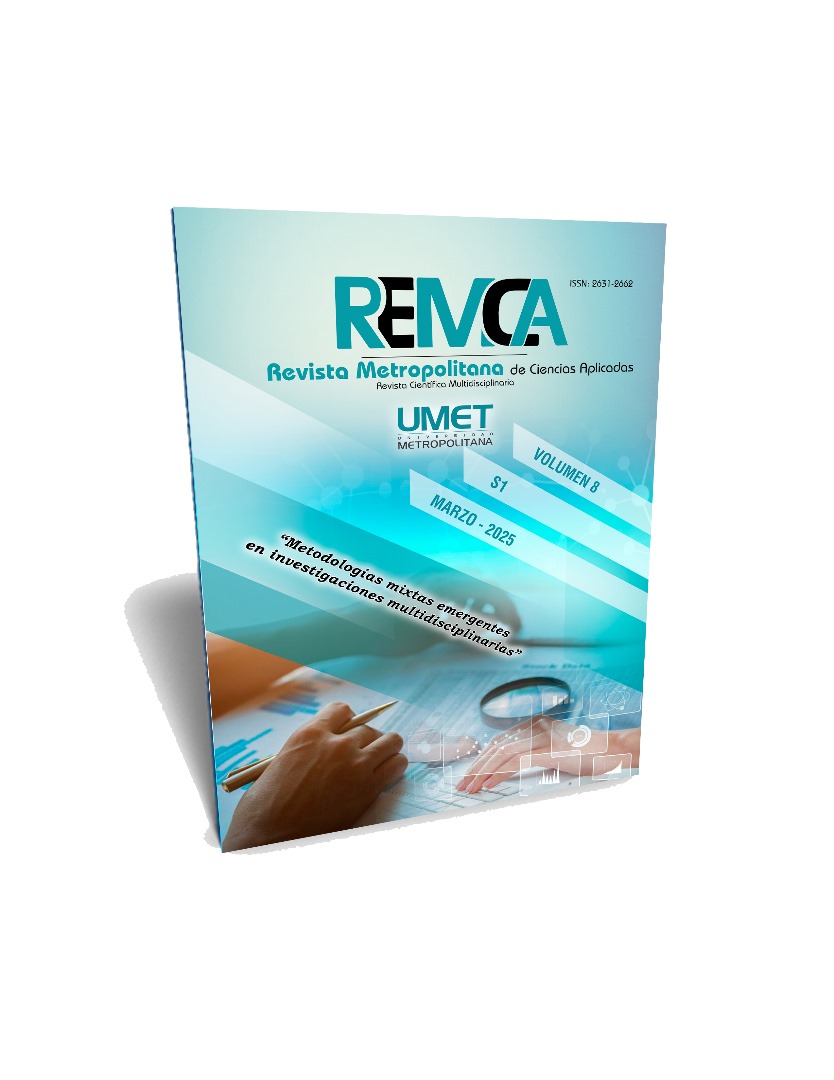Editorial
DOI:
https://doi.org/10.62452/d892e596Resumen
Estimados autores:
El Consejo Editorial de la Revista Metropolitana de Ciencias Aplicadas (REMCA), tiene el gusto de presentar el primer número especial del volumen 8, del año 2025. En esta ocasión este número monográfico reflexiona sobre las metodologías mixtas emergentes en investigaciones multidisciplinarias.Las metodologías mixtas pueden conceptualizarse como la combinación de metodologías de investigación cuantitativas y cualitativas.
Los enfoques con metodologías mixtas se consideran superiores a las investigaciones con métodos individuales. La investigación con metodologías mixtas da solución a preguntas que otros paradigmas no pueden. En este contexto, los métodos utilizados por los investigadores dependen de las características del problema, el objeto que se investiga y las preguntas que clarifican. En los últimos años existe la tendencia de investigaciones donde se combinan enfoques de modo que sirvan como punto de partida para el otro, y que puedan complementarse para ex-plorar distintos aspectos de la realidad.
Se constituyen emergentes cuando asumen el reto de realizar investigaciones en entornos tecnológicos, como el análisis de redes sociales, el empleo del big data con efectos sociales o económicos significativos.El Consejo Editorial de la Revista Metropolitana de Ciencias Aplicadas agradece a autores y revisores por sus contribuciones y hace la convocatoria para futuros números.
Descargas
Descargas
Publicado
Número
Sección
Licencia
Derechos de autor 2025 PhD. Jorge Luis León-González (Autor/a)

Esta obra está bajo una licencia internacional Creative Commons Atribución-NoComercial-CompartirIgual 4.0.
Los autores que publican en la Revista Metropolitana de Ciencias Aplicadas (REMCA), están de acuerdo con los siguientes términos:
1. Derechos de Autor
Los autores conservan los derechos de autor sobre sus trabajos sin restricciones. Los autores otorgan a la revista el derecho de primera publicación. Para ello, ceden a la revista, de forma no exclusiva, los derechos de explotación (reproducción, distribución, comunicación pública y transformación). Los autores pueden establecer otros acuerdos adicionales para la distribución no exclusiva de la versión de la obra publicada en la revista, siempre que exista un reconocimiento de su publicación inicial en esta revista.
© Los autores.
2. Licencia
Los trabajos se publican en la revista bajo la licencia de Atribución-NoComercial-CompartirIgual 4.0 Internacional de Creative Commons (CC BY-NC-SA 4.0). Los términos se pueden consultar en: https://creativecommons.org/licenses/by-nc-sa/4.0/deed.es
Esta licencia permite:
- Compartir: copiar y redistribuir el material en cualquier medio o formato.
- Adaptar: remezclar, transformar y crear a partir del material.
Bajo los siguientes términos:
- Atribución: ha de reconocer la autoría de manera apropiada, proporcionar un enlace a la licencia e indicar si se ha hecho algún cambio. Puede hacerlo de cualquier manera razonable, pero no de forma tal que sugiera que el licenciador le da soporte o patrocina el uso que se hace.
- NoComercial: no puede utilizar el material para finalidades comerciales.
- CompartirIgual: si remezcla, transforma o crea a partir del material, debe difundir su creación con la misma licencia que la obra original.
No hay restricciones adicionales. No puede aplicar términos legales ni medidas tecnológicas que restrinjan legalmente a otros hacer cualquier cosa que la licencia permita.




